I have used Amazon affiliate links on this page. As an Amazon Associate, I earn a commission from qualifying purchases at no added cost to you. Thank you!

Table of Contents
Strawberry Peacock Cichlid
If you love the idea of a vibrant, colorful tank with a variety of vivid, stout fish, then the Peacock Cichlids are for you. There are many varieties/species of peacock cichlids, and today we are going to focus on the Strawberry Peacock Cichlid. This fish is also known as pink peacock cichlids. They are striking fish hail from the southern part of Lake Malawi in Central East Africa, where they live in shallow waters and hunt smaller, sandy-dwelling fish. Their habitats are rich in rocky caverns that provide a safe haven as they swim freely around their colorful world, searching for prey ad hiding from bigger predators.
Genus Aulonocara & the Strawberry Peacock Cichlid
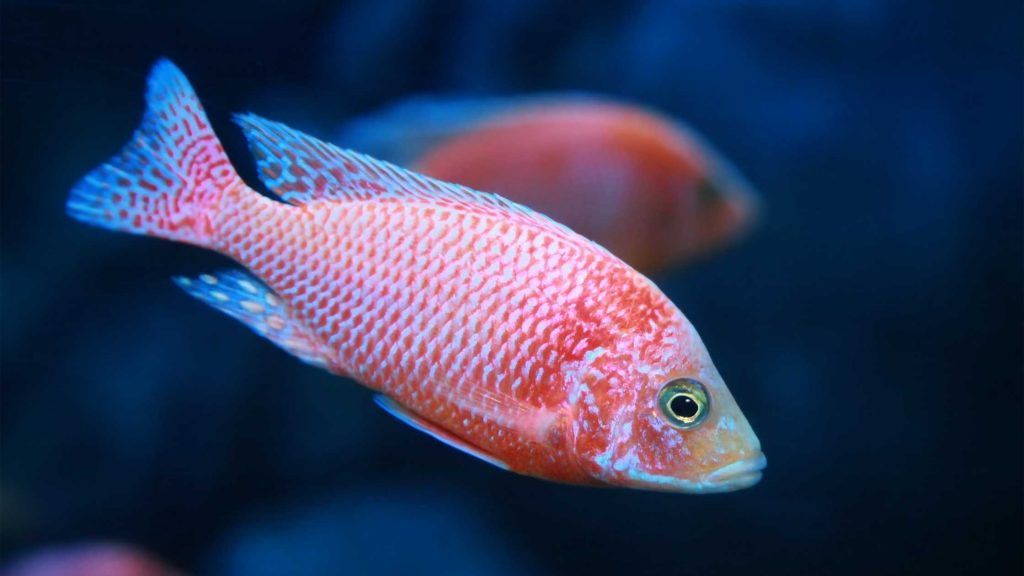
Strawberry Peacock Cichlid falls into the Genus Aulonocara. In other words, it’s one of the many Aulonocara species. Aulonocaras are noted for their maternal mouthbrooding and bold coloration. These fish are known as peacocks in the aquarium trade because of their beautiful colors and ability to attract nearby females. Yes, they are extremely sexually dichromic just like real peacock males and females. Their colors can range from dark shades of blue to bright yellow, and they have been bred with other species to create new colors, such as orange, purple, and brown.
Temperament of the Strawberry Cichlid
Strawberry peacock cichlid is a semi-aggressive cichlid just like other peacock cichlids. However, the males will start their own territories which are quite normal. This behavior should not harm the other fish in the tank provided an adequate amount of space.
Tank mates of Strawberry Peacock Cichlid
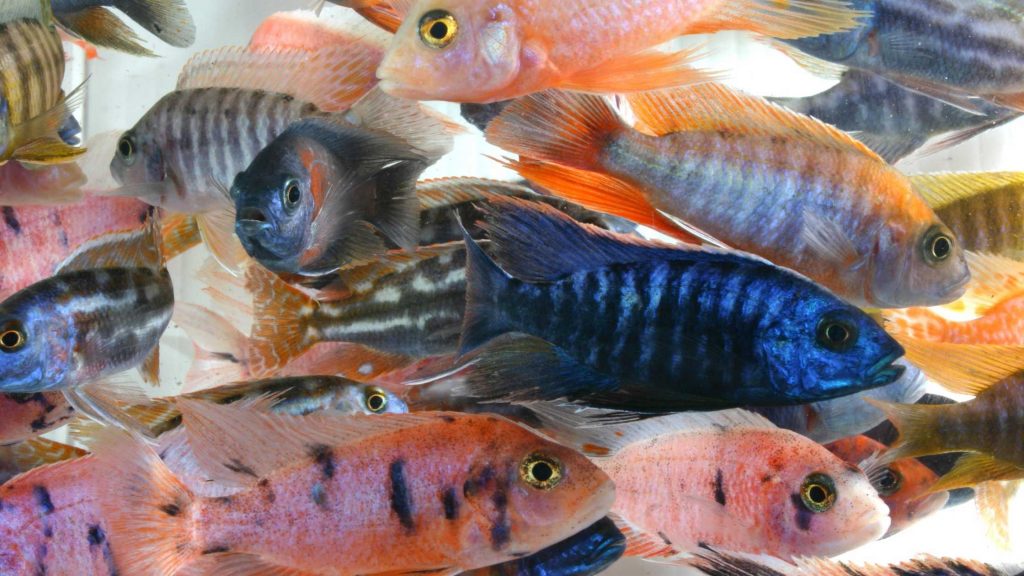
When you’re keeping strawberries, it’s important to have the right tankmates for your cichlid. Some of the best strawberry cichlid tankmates are catfish and plecos. Avoid adding live plants, as strawberry cichlids may dig them up to establish territory or eat them.
Other peacock cichlid species like Blue Peacock Cichlid, Dragon Blood Peacock Cichlid, Red Peacock Cichlid can make a great community tank with the strawberry peacock cichlid.
Full Grown Strawberry Peacock Cichlid Size
Just like other peacock cichlids, full grown strawberry peacock cichlid size depend on their gender. The male strawberry peacock cichlid is bigger than the female. When fully grown male strawberry cichlid is around half a foot or 6 inches.
The strawberry peacock cichlid female can grow up to 4 inches. full grown strawberry peacock cichlid
Life Span of Strawberry Peacock Cichlid
Strawberry peacock cichlid can live around 5 to 8 years, provided the optimal water conditions, diet and space. So make sure to read on.
Recommended Tank Size for the Strawberry Peacock
The recommended minimum strawberry cichlid tank size is 55 to 60 gallons per fish. In the wild, peacocks inhabit large territories of the lake, depending on the availability of food and water. So, in captivity, a fish tank of at least 55 gallons will allow your pet to thrive.
When you get a group of strawberry peacocks, a larger tank is a must with plenty of areas for hiding and forming territories.
Optimal Water Parameters
- Recommended pH Range: 7.5-8.5
- Hardness of the water: 10-15KH (Carbonate Hardness)
- Temperature: 22–28 °C
Strawberry Peacock cichlid is a species that was discovered in Lake Malawi in Africa. Their typical water habitat exhibits a warmer temperature. Because the habitat is so consistent and other water parameters like PH and KH stay pretty consistent throughout the year. Strawberry Peacocks prefer their tank water to be within those same parameters, which can make it difficult to maintain the correct conditions for an aquarium.
Since you like Malawi Cichlids, you might want to read about Red Empress Cichlid.
Scaping a Strawberry Peacock Tank
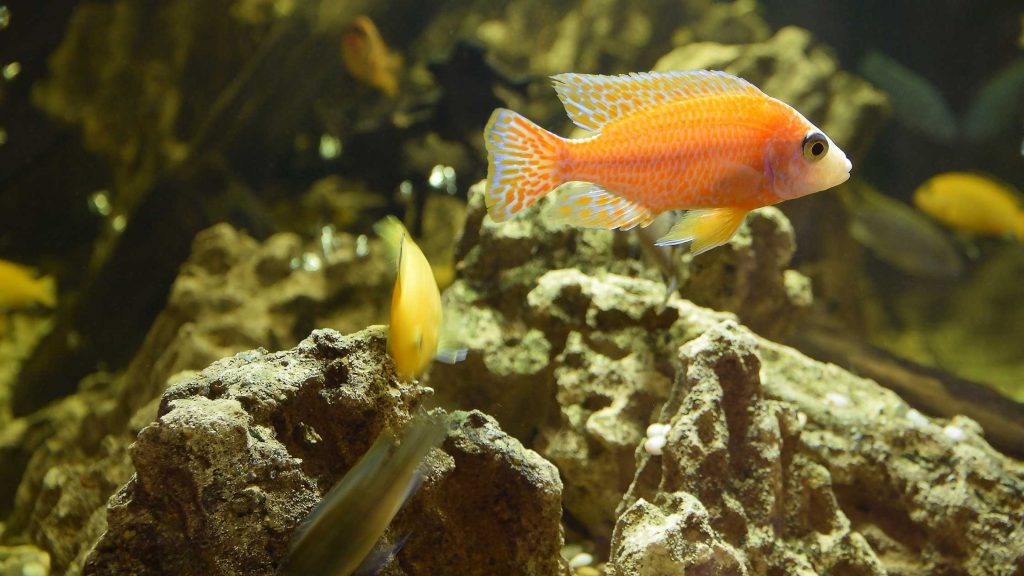
Aqua scaping an aquarium depends on the fish species that you are going to put in. Picture the lake Malawi cichlid habitat in your mind, and it will be a lot easier for you to scape your strawberry peacock tank.
Sand Substrate and Rocky Scape
As with other peacock cichlids, these fish also spend a lot of time digging the lake bottom looking for prey. So you can expect this to happen in your aquarium as well. So go with a sand substrate and avoid any gravel with sharp edges.
Peacock cichlids need rocky caves as hiding places to feel confident and form territories. So try to mimic a rocky bottom with added driftwoods and blend it with the sandy substrate to replicate their natural south Malawi lake habitat.
The aqua scaping for strawberry cichlid should be similar to red empress cichlid aquascape. Shown below.
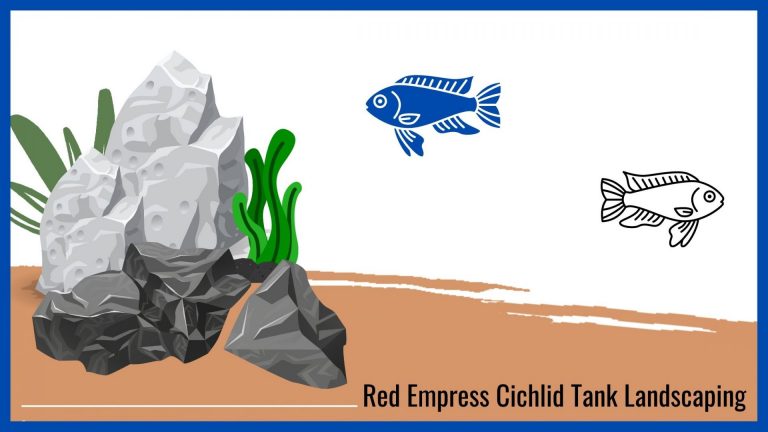
Aqua plants and Strawberry Peacock Cichlid
The digging nature of this Cichlid and the sand substrate make it harder for the delicate bottom growing plants to thrive. Try plants like Anubias or Java Fern glued on the driftwoods and placed among the rocks. These hardy plants are the best option you can go with this strawberry cichlid.
The peacock cichlids won’t eat plants, so don’t worry about them eating your anubias.
Strawberry Peacock Cichlid Diet
Peacock cichlids are omnivores, but they’re born predators. Peacocks have a varied diet, including invertebrates like insects, crustaceans like shrimp, and meat like small fish.
A typical peacock cichlid diet should consist of a quality sinking pellet supplemented with meaty and vegetable foods. Strawberry peacock cichlids enjoy live insects such as crickets, along with frozen brine shrimp or Daphnia.
Check out the below Strawberry Peacock Cichlid Diet products that you can buy online:
Issues related to feeding
Incorrect feeding habits can always lead to disasters in aquariums. This is true with peacock Cichloids as well.
Overfeeding & Malawi Bloat
Avoid overfeeding by giving your fish small meals throughout the day. This also helps the aquarium’s filtration as the beneficial bacteria will have enough time a smaller load of food residuals and fish waste to break down and keep ammonia at bay.
Overfeeding a strawberry peacock cichlid can also cause Malawi bloat, which is a deadly and painful condition for this species. To prevent it, as mentioned in the above section feed your fish several smaller meals per day.
Also, avoid feeding too much mammalian meat and worms.
The bottom line is when you feed your cichlid right, you ensure that the tank’s water parameters remain normal and prevent toxicity from building up. The result is healthy and happy fish!
Common health issues of Strawberry Peacock Cichlid
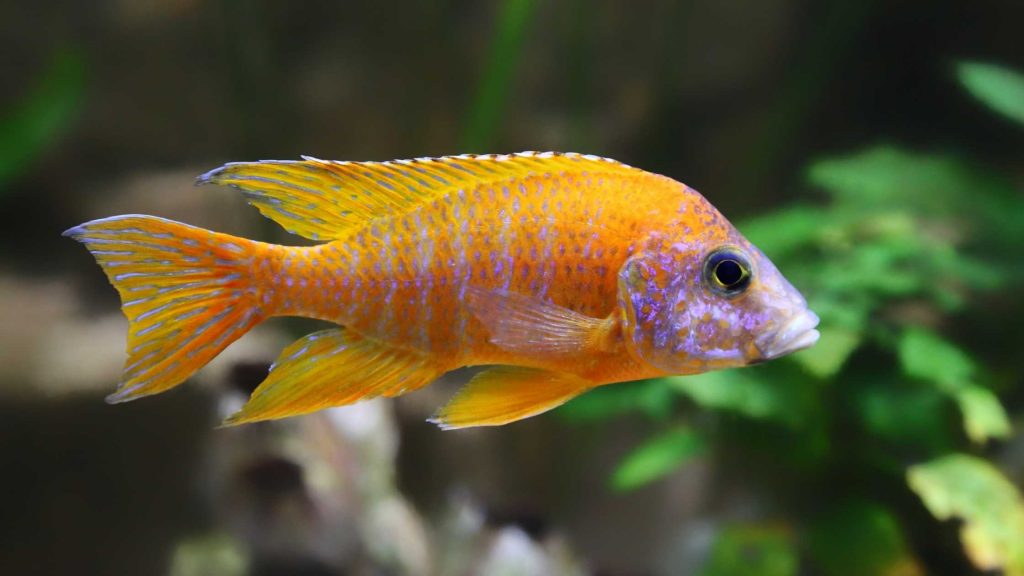
Malawi Bloat
Malawi bloat is a possibly fatal condition that results from eating an excess of mammalian meaty foods, worms and affects the liver, kidney, and swim bladder. Symptoms include a lack of appetite, abdomen swelling, and labored respiration while laying at the bottom of the aquarium. The disease is so dangerous that severe cases can result in death within one to three days.
Tuberculosis
Fish tuberculosis is a horrible illness that strikes many fish species, including the strawberry peacock cichlid. Symptoms include lack of appetite, popeyes, ulcers, frayed fins, a sunken abdomen, and White feces on the fish’s body. In most cases, fish tuberculosis is fatal and can affect entire tank populations within a short time.
The best way to prevent this illness is to properly quarantine any new plants, fish, driftwood, and other decors before introducing them into your peacock cichlid tank.
Breeding the Strawberry Cichlid
The male strawberry peacock cichlid has a reputation for being a bit of a player. But if he’s ready to settle down, he’ll start to do a mating dance/movement pattern to attract the female.
If his advances are successful, the female lays her eggs in front of the male’s cave, giving him a chance to fertilize them.
A mouth-brooding female strawberry peacock cichlid will collect the fertilized eggs in her mouth and go to the cave to incubate them. She will keep them there in her mouth and then spit them into the cave once they become free-swimming.
Pro Tip: You can encourage the breeding process, by slightly raising the water temperature.
Conclusion
Strawberry peacock cichlid is a beautiful fish suitable for a species tank with other Genus Aulonocara species in it. They do well with community tanks as well but make sure to add the same size and semi-aggressive cichlids and fish like plecos and catfish. Do not add small invertebrates and crustaceans with this fish as they will be eaten rather quickly. Strawberry cichlid loves a habitat with a rocky environment and sand substrate mimicking the natural habitat of Malawi lake. This is a bit sensitive to changing water parameters, so make sure to have your heater and the filtering system working properly. Given the stable water condition and enough space to roam and form territories, they will stay healthy, display bright colors, and even starts breeding. You may earn a side income by selling some of your bred fish as the demand for this fish is great all year long.




